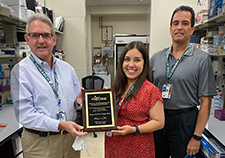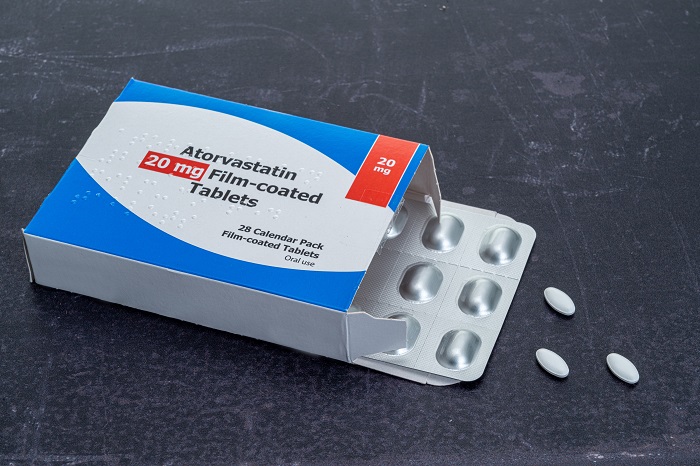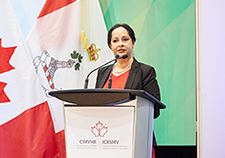Office of Research & Development |
 |


The VA Diabetes Trial is one of several large clinical trials that has helped guide diabetes care for Veterans and others. (Photo for illustrative purposes only. ©iStock/Fertnig)
October 24, 2018
By Mike Richman
VA Research Communications
Long-term follow-up of a major VA diabetes study shows that patients who received intensive therapy to lower blood sugar levels did not see a significant drop, on average, in heart attacks, strokes, and other cardiovascular events.
"One interpretation...is that good glycemic control is beneficial. But it must be sustained or the benefit is lost."
In 15-year findings from the VA Diabetes Trial (VADT), researchers concluded that nearly six years of aggressive lowering of blood sugar levels resulted in a non-significant 12 percent decline in cardiovascular events—a composite of heart attack, stroke, cardiovascular death, congestive heart failure, and amputation from gangrene—when compared with standard therapy. The cohorts also showed no differences in all-cause death, and a long-term trend for reduced renal (kidney) events was insignificant.
In the earlier 10-year follow-up, the results of which were published in the New England Journal of Medicine in 2015, patients in the aggressive blood sugar-lowering group had a significant 17 percent drop in cardiovascular events. But that decline didn’t extend to 15 years, by which time blood sugar levels had merged between the two groups. That suggested there was no carry-over benefit, or “legacy effect,” from the earlier period.
When differences between study groups aren’t sharp enough to reach the threshold of statistical significance, researchers assume they are just as likely due to chance as to the study intervention.

VA Study Documents Health Risks for Burn Pit Exposures

VA center training the next generation of researchers in blood clots and inflammation

Could cholesterol medicine reduce dementia risk in seniors?

Million Veteran Program director speaks at international forum
Blood sugar, or glucose, levels rise higher than normal in people with diabetes. Reducing blood sugar to normal levels is also known as tight or intensive glycemic control. In less aggressive therapy, the goal may be to slightly lower levels but not to get them quite to normal.
“This points out how difficult it sometimes is to maintain tight glycemic control,” says Dr. Nicholas Emanuele, one of the three lead investigators on the VADT follow-up and a specialist in endocrinology, diabetes, and metabolism at the Edward Hines, Jr. VA Hospital in Illinois. “Outside the rigors of a precise protocol like the VADT, it’s easy for patients to let glucose control slip. It’s a tough disease in many ways.
“Remember, there was a significant cardiovascular benefit of good sugar control at 10 years,” he adds. “So, one interpretation of this is that good glycemic control is beneficial. But it must be sustained or the benefit is lost.”
Emanuele and his colleagues reported the 15-year findings at a symposium of the American Diabetes Association in June 2018 in Orlando, Florida. A paper summarizing the conclusions is now under review by the New England Journal of Medicine.
The researchers will be writing on the VADT and VADT follow-up in the coming years beyond what they’ve submitted to the New England Journal of Medicine. But no follow-up past the 15-year mark is planned at this point. According to Dr. Peter Reaven, another investigator on the VADT follow-up, the VADT results may differ from those of the UK Prospective Diabetes Study (UKPDS) and the Diabetes Control and Complications Trial (DCCT) because VA patients were sicker to begin with. Thus, their long-term outcomes were not as good.
Both the UKPDS and the DCCT achieved legacy effects over 25- and 30-year follow-ups, respectively.
“The glucose treatment differences in outcomes in the UKPDS and the DCCT persisted or increased,” says Reaven, head of the diabetes research program at the Phoenix VA Health Care System. “They didn’t go away and then come back. Also, the participants were earlier stage, less-advanced diabetes patients, with less prevalence of cardiovascular disease at study enrollment. So they were very different groups of patients than those in the studies where no legacy effect has been seen,” including the VA Diabetes Trial, the ACCORD Trial (Action to Control Cardiovascular Risk in Diabetes), and the ADVANCE Trial (Diabetes and Vascular Disease: Preterax and Diamicron MR Controlled Evaluation).
VADT, ACCORD, and ADVANCE all showed a modest decline in cardiovascular events at different points in their follow-up periods.
The VA Diabetes Trial, which began in 2000, was a randomized trial of intensive glycemic control in Veterans with advanced type 2 diabetes. It was sponsored by the VA Cooperative Studies Program. The 1,791 participants from 20 VA medical centers were at relatively high risk for cardiovascular disease, including heart attack and stroke. Many of the Vets already had cardiovascular disease when they enrolled in the study. The two cohorts were identical in gender (predominantly male), average age (61), and the number of years with diabetes (12).
The 15-year VADT follow-up included data through 2015.
At least 90 percent of adults with diabetes have type 2 diabetes, one of the three major types of the illness. The top cause of complications and death in patients with type 2 diabetes is cardiovascular disease. In type 2 diabetes, the pancreas fails to make enough insulin to keep blood glucose levels normal, often because the body does not respond well to insulin. (A deficiency of glucose in the bloodstream is called hypoglycemia.) If the blood vessel walls get sticky or blocked due to a buildup of plaque, normal blood flow to the heart is interrupted, triggering possible cardio problems.
Diabetes affects nearly 25 percent of VA's patient population. The illness is also the No. 1 cause of blindness, kidney disease, and amputation for VA patients. Symptoms of diabetes include blurry vision, excessive thirst, fatigue, frequent urination, hunger, and weight loss or gain.
People who are overweight or who smoke are among those at greater risk for type 2 diabetes. Most patients with the disease eventually need daily injections of insulin to lower their blood sugar levels. Their HbA1c levels are measured every few months.
Hemoglobin A1c (HbA1c) is a marker, along with blood pressure and cholesterol control, of good diabetes care. Hemoglobin, which carries oxygen through the body, is a protein found in red blood cells When glucose is attached to hemoglobin, it’s referred to as hemoglobin A1c.
Veterans in the two VADT groups took similar types of drugs to reduce their blood sugar levels for a median of 5.6 years, except that the dose or frequency was higher in the aggressive treatment group. The treatment goal was a reduction of blood glucose to an average HbA1c of 6.9 percent for Veterans in the more aggressive group, versus 8.4 percent for those in standard therapy—a separation of 1.5 percent. The target HbA1c level for those with diabetes is usually less than 7 percent.
In the 10-year follow-up, tight glycemic control was linked to a modest and significant decline in cardiovascular events. Patients in the intensive glucose-lowering group had 8.6 fewer events per 1,000 person-years than those in standard therapy.
According to Reaven, results from the 5.6-year treatment period prompted questions that triggered the follow-up study. One question was: Would a follow-up reveal a benefit related to cardiovascular disease, all-cause death, or other outcomes?
“This was particularly relevant, as there was an indication that the benefits were increasing toward the end of the study, and benefits in cardiovascular outcomes, as we know, take a fair amount of time,” Reaven said at the ADA symposium. “As glucose separation between the treatment groups was greater than that of recent studies in patients with advanced type 2 diabetes and (lasted for) an extended period, this provided an excellent opportunity to examine whether there was a legacy effect.
“Moreover,” he added, “as differences in mortality can take a fair amount of time, this gave us a chance to look for any long-term effects on mortality, such as hospitalizations or long-term quality of life changes, or if long-term harm may have become more apparent.”
But after all patients returned to their regular medication and dosage at the end of the treatment period, the 1.5 percent separation waned to no separation at all. The glucose levels merged at about 8 percent before the end of the 15-year VADT follow-up period.
“There did not appear to be a notable `legacy effect,’” Reaven says. “The benefit was mainly toward the end of the 10-year follow-up, when there was some separation in HbA1c. But it went away after HbA1c levels merged between the two groups.”
At the symposium, Emanuele reported the kidney and eye disease findings. They followed almost the same pattern as that of the cardiovascular conclusions.
The researchers found benefits to intensive glucose control on kidney health in the 10-year follow-up. “However, as glycemic separation wanes,” Emanuele said, “that benefit vanishes as well, very similar to the situation that Dr. Reaven presented with [cardiovascular events]. There’s no prolonged legacy effect.”
The kidney outcome was based on end-stage renal disease, which included dialysis or transplantation; very low levels of eGRF, a measure of the kidney’s ability to filter out poisons; or moderate increases in urine albumin, a sign of possible kidney damage.
For the eye conclusions, the researchers summarized data in two categories: cataract extraction—when the lens of the eye becomes opaque, resulting in blurred vision—and three procedures linked to retinal disease: laser photocoagulation, vitrectomy, and intravitreal injections. There was no benefit from aggressive glucose control in either category at 10 years, but a marginal benefit was seen in the retinal disease composite at 15 years.
So how should experts view the VADT and the VADT follow-up based on the results?
A researcher not associated with the study, Dr. Hertzel Gerstein, said there is a “legacy effect” when considering the 10-year follow-up results. He’s an endocrinologist and a professor at McMaster University in Ontario, Canada.
“What does leaving a legacy mean?” Gerstein asked during the ADA symposium. “Well, VADT showed that about 5.6 years of more versus less glucose lowering reduces cardiovascular outcomes during 10 years of follow-up, but not during 15 years of follow-up. I think there was a 10-year legacy because after the end of the clinical trial there’s still a benefit a few years later. “There’s no right answer here. It’s just the way you think of it.”
As to Gerstein’s contention that there has been a legacy effect of sorts among the VADT patients, Reaven concedes that the difference between that view and his own—that there was no legacy effect—may be one of semantics.
Emanuele notes that the VADT is widely referenced in academic papers on diabetes and in clinical guidelines, such as those of the American Diabetes Association and the American Association of Clinical Endocrinologists. The trial continues to provide diabetes insights and inform care, including the fact that glucose-lowering reduces the consequences of diabetes on average, he says.
The impact of the VADT and the VADT follow-up is “proof that good blood glucose control reduces cardiovascular events, deterioration of kidney function, and possibly the need for treatments of eye disease,” Emanuele says. “However, it appears that this good control must be sustained for benefits to be sustained.”
VA Research Currents archives || Sign up for VA Research updates